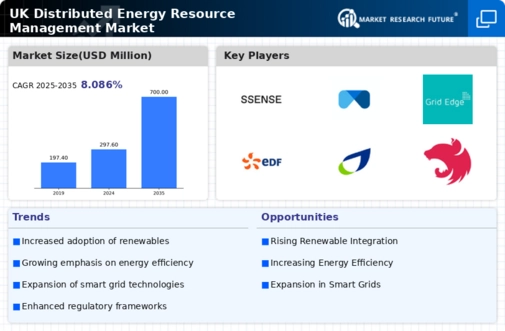Rising Energy Costs and Economic Pressures
The distributed energy-resource-management market in the UK is influenced by rising energy costs and economic pressures faced by consumers and businesses. As energy prices continue to escalate, there is a growing impetus for individuals and organisations to seek alternative energy solutions. The increasing cost of traditional energy sources has prompted a shift towards distributed energy resources, which can provide more stable and potentially lower energy costs over time. In 2025, energy prices are expected to rise by approximately 15% compared to previous years, further motivating the adoption of distributed energy solutions. This economic landscape is likely to drive demand for innovative energy management systems within the distributed energy-resource-management market.
Technological Innovations in Energy Storage
Technological advancements in energy storage systems are pivotal for the distributed energy-resource-management market in the UK. The development of more efficient battery technologies, such as lithium-ion and flow batteries, has enhanced the viability of renewable energy sources. These innovations allow for better energy management, enabling consumers to store excess energy generated during peak production times for later use. As of 2025, the energy storage capacity in the UK is projected to reach approximately 10 GW, reflecting a growing trend towards self-sufficiency in energy management. This increase in storage capacity is likely to facilitate the integration of renewable energy sources, thereby driving the distributed energy-resource-management market forward.
Emergence of Peer-to-Peer Energy Trading Models
The distributed energy-resource-management market in the UK is witnessing the emergence of peer-to-peer energy trading models, which are reshaping traditional energy consumption patterns. These models enable consumers to buy and sell excess energy generated from renewable sources directly with one another, fostering a more decentralised energy system. As of 2025, several pilot projects are underway, demonstrating the feasibility and benefits of such trading platforms. This innovative approach not only empowers consumers but also enhances energy efficiency and reduces reliance on centralised energy providers. The rise of peer-to-peer trading is likely to stimulate further growth in the distributed energy-resource-management market, as it aligns with the increasing demand for energy independence and sustainability.
Regulatory Support for Decentralised Energy Solutions
The distributed energy-resource-management market in the UK benefits from robust regulatory frameworks that encourage decentralized energy solutions. The UK government has implemented various policies aimed at promoting renewable energy and energy efficiency. For instance, the Feed-in Tariff scheme has incentivised the adoption of small-scale renewable technologies, allowing consumers to generate their own energy. This regulatory support is crucial as it not only fosters innovation but also enhances the market's attractiveness to investors. As of 2025, the UK aims to achieve net-zero emissions by 2050, which necessitates a significant increase in distributed energy resources. This regulatory environment is likely to drive growth in the distributed energy-resource-management market, as stakeholders seek to align with national energy goals.
Increased Focus on Sustainability and Carbon Reduction
The market in the UK is experiencing a heightened focus on sustainability and carbon reduction initiatives. As public awareness of climate change grows, consumers are increasingly prioritising environmentally friendly energy solutions. The UK government has set ambitious targets for reducing carbon emissions, aiming for a 68% reduction by 2030 compared to 1990 levels. This commitment to sustainability is driving investments in distributed energy resources, as businesses and households seek to align with these environmental goals. The shift towards sustainable energy practices is likely to enhance the growth of the distributed energy-resource-management market, as stakeholders recognise the importance of reducing their carbon footprint.






















Leave a Comment